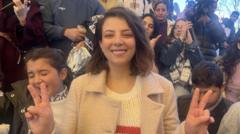In the working-class neighborhood of Mezzeh 86 in Damascus, the atmosphere reflects a mix of anticipation and trepidation among members of the Alawite sect, a significant religious minority that dominated Syria's political landscape during the decades of Assad's rule. With the regime's downfall at the hands of Sunni Islamist group Hayat Tahrir al-Sham (HTS), fears of reprisals from former opposition groups are growing palpable.
Many Alawites we spoke to expressed their reluctance to discuss their experiences openly, a reflection of their anxiety over potential retribution. While bashar al-Assad governed the nation for 24 years, it was the Alawite community that largely filled the ranks in the government and military. One young pharmacy student, Mohammad Shaheen, noted the misperceptions of wealth and privilege associated with Alawites, contradicting the reality of widespread poverty among the sect.
Witnesses spoke of the emotional fallout from Assad's unexpected departure and the chaotic consequences that ensued. Some Alawites have chosen to flee due to the fear of revenge from opposition forces, while others, who claim to have no personal involvement in oppressive military actions, remain in Damascus and express cautious optimism about their current situation.
As HTS extends its influence in the region, the group claims intentions to uphold the rights of minorities while holding accountable those from the previous regime who committed atrocities. However, doubts linger about HTS's true commitment to a pluralistic society due to its Islamic affiliations and past jihadist connections.
Christians, another significant minority, embody a more mixed sentiment. Some, like lawyer Youssef Sabbagh, celebrate the regime's fall while maintaining concern over HTS's rise. Gatherings in Christian areas, decorated for celebrations and open businesses, suggest some reassurance but also a desire for normalcy and security in the face of shifting power dynamics.
Traveling further south to Suweida, the epicenter of the Druze community, the ambiance is distinctly celebratory among protesters who have rallied against the regime. Activist Wajiha al-Hajjar described a spirit of resilience within the Druze, who seek to preserve their quasi-autonomous status and advocate for equal rights in the newly emerging political landscape.
Holistically, the diverse voices from Syria's minority communities underscore the nuanced dynamics at play in the post-Assad era. As tensions persist, the future of these communities within a rapidly evolving sociopolitical environment remains uncertain. The expression of hope for systemic change mingles with fears that new leadership might not differentiate from previous regimes in ensuring pluralism and security.
Many Alawites we spoke to expressed their reluctance to discuss their experiences openly, a reflection of their anxiety over potential retribution. While bashar al-Assad governed the nation for 24 years, it was the Alawite community that largely filled the ranks in the government and military. One young pharmacy student, Mohammad Shaheen, noted the misperceptions of wealth and privilege associated with Alawites, contradicting the reality of widespread poverty among the sect.
Witnesses spoke of the emotional fallout from Assad's unexpected departure and the chaotic consequences that ensued. Some Alawites have chosen to flee due to the fear of revenge from opposition forces, while others, who claim to have no personal involvement in oppressive military actions, remain in Damascus and express cautious optimism about their current situation.
As HTS extends its influence in the region, the group claims intentions to uphold the rights of minorities while holding accountable those from the previous regime who committed atrocities. However, doubts linger about HTS's true commitment to a pluralistic society due to its Islamic affiliations and past jihadist connections.
Christians, another significant minority, embody a more mixed sentiment. Some, like lawyer Youssef Sabbagh, celebrate the regime's fall while maintaining concern over HTS's rise. Gatherings in Christian areas, decorated for celebrations and open businesses, suggest some reassurance but also a desire for normalcy and security in the face of shifting power dynamics.
Traveling further south to Suweida, the epicenter of the Druze community, the ambiance is distinctly celebratory among protesters who have rallied against the regime. Activist Wajiha al-Hajjar described a spirit of resilience within the Druze, who seek to preserve their quasi-autonomous status and advocate for equal rights in the newly emerging political landscape.
Holistically, the diverse voices from Syria's minority communities underscore the nuanced dynamics at play in the post-Assad era. As tensions persist, the future of these communities within a rapidly evolving sociopolitical environment remains uncertain. The expression of hope for systemic change mingles with fears that new leadership might not differentiate from previous regimes in ensuring pluralism and security.




















